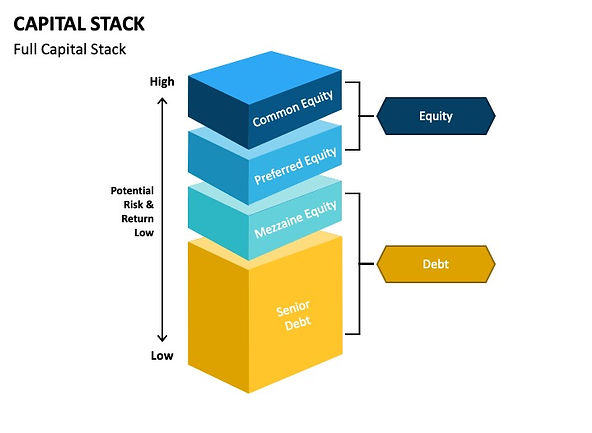
What Doctors Need To Know About The Capital Stack In Syndications
For doctors who invest in syndications it is like embarking on a thrilling adventure, but it's not without its risks and challenges. To navigate this terrain successfully, one needs a good understanding of the "capital stack." This financial concept acts as a compass, helping investors gauge their risk exposure and anticipate potential returns in a real estate investment. Whether you're a seasoned investor or just dipping your toes into the real estate waters, your position in the capital stack is vital, as it dictates your priority in the pecking order when it comes to claims on the deal's capital.
In this article, we'll discuss the capital stack, unraveling its various layers, including senior debt, mezzanine debt, preferred equity, and common equity.
What Is The Capital Stack Anyway
The capital stack in real estate is the architectural blueprint of your financial skyscraper. It delineates the hierarchy of capital sources employed to acquire a property, clarifying who holds rights (and in what sequence) to income, profits, and even the property itself in case of foreclosure.
Think of it as a visual representation, akin to a layered cake, highlighting the diverse forms of capital involved in the deal. Essentially, the capital stack comprises distinct tiers within the deal's financial structure, outlining the order in which investors are reimbursed from generated profits during the holding period and specifying the rights to repayment in the event of a default.

1. The Foundation: Senior Debt (The Bank Or Lender)
At the base of the capital stack lies senior debt, forming the bedrock of the structure. Despite its position at the bottom, senior debt holds the first position, leveraging the property as collateral. This means that, should the property underperform and fail to generate sufficient cash flow to cover its debt service (or mortgage), senior debt investors are the first in line for repayment.
In exchange for this lower risk, senior debt typically yields the smallest return on capital. It often constitutes a significant portion of the total project cost, roughly around 75%, although this can fluctuate depending on factors such as the property's risk profile, market conditions, and the borrower's creditworthiness.
2. Stepping Up: Mezzanine Debt
Mezzanine debt occupies a rung just below senior debt in the hierarchy, securing a higher return but at the cost of increased risk. Unlike senior debt, it isn't backed by the property itself but by a pledge of ownership interest. While the mezzanine debt holders possess limited foreclosure rights, these rights are typically constrained by the senior debt agreement. Mezzanine debt investors often share in the profits, somewhat akin to common equity investors, and may even receive a portion of the sale profits.
3. The Middle Ground: Preferred Equity
Preferred equity rests in the middle tier of the capital stack, sandwiched between debt holders and common equity investors. These investors demand a higher return compared to debt holders but generally expect lower returns than common equity holders. Preferred equity often enjoys benefits like a share of appreciation and profits in the form of distributions, making it somewhat of a hybrid between common equity and mezzanine debt.
They typically share in some upside and may receive recurring payments, although the terms can vary. Preferred equity can be categorized as "hard" (requiring payment regardless of cash flow) or "soft" (conditional on sufficient cash flow).
4. The Apex: Common Equity
Common equity occupies the highest position in the capital stack, making it the riskiest but potentially most rewarding. As the last in line for payment, common equity investors bear the brunt of the risk. They receive distributions from the property's profits, although these distributions are not guaranteed. Common equity investors get a share of the profits when the property is sold and also benefit from any appreciation. Importantly, common equity investors have ownership rights in the property, pledging it as collateral and adhering to the rules of those lower in the capital stack.
However, if the property depreciates during the holding period, common equity investors may not receive distributions or profits upon liquidation, potentially risking part or all of their principal. Often, common equity comes from the project's sponsors or general partners, signifying their commitment by investing their own money. It's worth noting that potential returns for common equity investors typically have no upper limit, making it both high-risk and high-reward.
In Conclusion: Navigating Real Estate Risk and Reward
In real estate investments, risk is an ever-present companion. Understanding the capital stack and your place within it is paramount in assessing the risk-to-reward ratio for your anticipated returns. While investors' risk tolerances vary, many find themselves positioned at the common equity or preferred equity levels of the capital stack.
By understanding the capital stack, real estate investors can make informed decisions, effectively balancing risk and reward in their pursuit of profitable property investments. I’d love to share upcoming deals with you, but first we need to talk so I can hear about your investing goals and help you determine capital stacks that will be favorable for you.
Apply today at Nima Equity Doctors Investing Club to get the “inside scoop” on our past and upcoming deals. Once you apply to join the club, I’ll get on a call with you so we can see if we’re a good fit to invest alongside each other on any future real estate syndication deals! I can’t wait!
